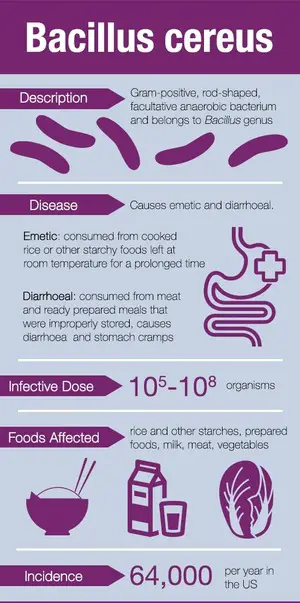Fried rice syndrome refers to a foodborne illness caused by Bacillus Cereus, a type of bacteria that forms spores that release harmful toxins. People become infected when they ingest food contaminated with the bacteria. Signs and symptoms of the syndrome may include diarrhea and vomiting.
Food poisoning, or foodborne illness are common issues today. Fried rice syndrome occurs when contaminated food is improperly cooled and left to sit at room temperatures for long periods of time. The duration allows the bacteria and its spores to multiply to unsafe levels. Foods that lead to fried rice syndrome are already contaminated with B. Cereus prior to cooking and leaving them out. The contamination occurs when the spores are given time to release harmful toxins. B. Cereus can cause two forms of gastrointestinal illness. Fried rice syndrome is usually associated with the emesis form.
B. Cereus
B. Cereus thrives in carbohydrates other than rice as well. Cases of the foodborn illness have been reported with pasta and potatoes. Fried Rice Syndrome gets its moniker from cooked white rice that wasn’t refrigerated and then was later used to make fried rice dishes in restaurants.

When B. Cereus is in proteins, the result often is a diarrheal illness. Campylobacter and Salmonellaare are the leading caused of bacterial enteric infections that can cause foodborne illnesses. They primarily affect the gastrointestinal tract, also known as the enteric system.
Campylobacter is typically found in raw or undercooked poultry, unpasteurized milk, and contaminated water. It can also be present in meat, particularly beef and pork, as well as other foods that come into contact with contaminated surfaces or utensils.
Salmonella enterica is the most common cause of salmonellosis in humans. It can be found in a variety of foods, including raw or uncooked poultry, dairy products, fruits and vegetables.
For Campylobacter the incubation period is typically between 2 and 5 days, with symptoms often developing within 2 to 10 days after exposure.
For Salmonella enterica the incubation period is typically between 6 and 72 hours, with symptoms developing often after 6 days.
USDA Guidelines
The USDA has guidelines for cooking cooling and storing food properly. Proper food handling, cooking and hygiene practices are crucial in preventing bacterial infections. When done, it reduces the risk of becoming infected with B. Cereus. They include:
- Eat cooked foods as soon as possible.
- Keep hot foods at 135 degrees or higher until they are served
- Refrigerate all cooked or perishable foods within two hours and make sure the fridge is set to 40 degrees Fahrenheit or cooler,
- If the surrounding temperature is higher than 90 degrees, leftovers need to be refrigerated after one hour.
- Divide leftovers into small containers to help them cool faster.
- Reheat leftovers to an internal temperature of 165 degrees Fahrenheit before eating.
- Do not eat leftovers in the fridge that have been there for more than four dauys.
- When in doubt, throw it out.
According to the Cleveland Clinic, almost 64,000 outbreaks of B. Cereus occur each year in the United States. The incubation time for B. Cereus is very short, and symptoms usually start within one to six hours. In normal healthy people the poisoning often resolves itself in 24 hours. People who are immunocompromised or have underlying health conditions may develop serious illness from the infection.
While above is not medical advice, and information only, please contact your medical doctor for formal medical advice.
Barry Schustermann
Follow me on X @BarrySchust
Follow me on Facebook @ Barry Schustermann


1 thought on “Understanding Fried Rice Syndrome and Foodborne Illness”